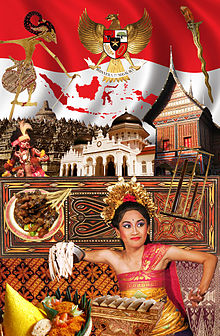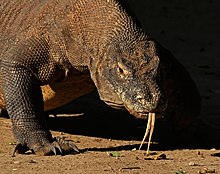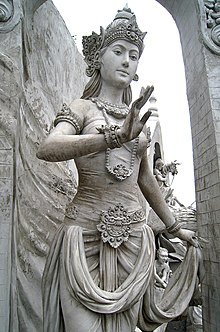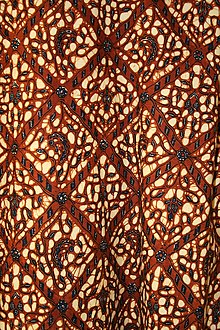National symbols of Indonesia
| Part of a series on the |
| Culture of Indonesia |
|---|
 |
| People |
| Languages |
| Mythology and Folklore |
| Cuisine |
|
Literature |
| Music and Performing arts |
| Sport |
National symbols of Indonesia are
.Other than these official national symbols of Indonesia, there are also other symbols that widely recognise and accepted to represent Indonesia, yet does not necessarily being enforced by Indonesian laws. However some symbols that previously unofficially recognised and had not enforced by law finally gain official recognition through law edict, such as Indonesian national flora and fauna that enforced by law in 1993.
Official national symbols
Official national symbols of Indonesia are national symbols of Indonesia that represent Indonesian nationhood. These symbols are recognised as official symbols that represent Republic of Indonesia and usually displayed in Indonesian government institution buildings, Indonesian embassies, Indonesian passport, or held by Indonesian representatives in international events, such as diplomatic or sporting events. These national symbols are enforced through Indonesian laws. The Constitution of Indonesia 1945 Chapter XV specifies the flag, official language, coat of arms, and national anthem of Indonesia.[1] The Indonesian law No. 24 year 2009 mentioned about the Indonesian flag, Indonesian language, national emblem of Indonesia, and national anthem of Indonesia.[2]
National emblem of Indonesia
National motto
It is a quotation from an Old Javanese poem
Flag of Indonesia
The national flag of Indonesia, which is known as
National anthem of Indonesia
National language of Indonesia
Indonesian is the official language of Indonesia. The function of Indonesian language is as the national identity, national pride, and unifying language among diverse Indonesian ethnic groups, and also serves as communication vehicle among Indonesian provinces and different regional cultures in Indonesia.[2]
National flora

There are three categories of
- National flower (Indonesian: Puspa bangsa) of Indonesia is Melati putih (Jasminum sambac)[8]
- Flower of charm (Indonesian: Puspa pesona) is Anggrek Bulan (Moon Orchid) (Phalaenopsis amabilis)[9]
- Rare flower (Titan arum) was also added as puspa langka together with Rafflesia.
National fauna

Indonesian animal emblems are Indonesian endemic fauna that gain the status as national animal symbol that represent Indonesia and describe Indonesian biodiversity. Today there are three animals that gained the status as Indonesian animal emblems:
- National animal (Indonesian: Satwa bangsa) of Indonesia is Komodo dragon (Varanus komodoensis)
- Rare animal also National bird (Indonesian: Satwa langka) is Javan hawk-eagle (Nisaetus bartelsi)
- Animal of charm (Indonesian: Satwa pesona) is Asian arowana (Scleropages aureus and Scleropages legendrei)
Next to national animal symbols, there are also more specific provincial animals emblems that represent each respective provinces of Indonesia.
National gem
Indonesia national gem are Batu Intan (Diamond)[8][failed verification] as the national gem, especially Batu Intan from Martapura and Cempaka, Banjarbaru.
Unofficial national symbols
Other than national symbols that officially represent Indonesia and enforced through law, there are also other symbols or icons that widely accepted to describes or represents Indonesia. It might derived from Indonesian monuments, the popular architectural
National personification of Indonesia

Nusantara (Indonesian archipelago)
National monuments
Other vernacular
National culture

Some of traditional
National costume
National dish
For the
See also
References
- ^ – via Wikisource.
- ^ People's Representative Council. 2009.
- ^ "State Emblem". Indonesia.go.id. Archived from the original on 9 April 2012. Retrieved 23 March 2012.
- ^ Santoso, Soewito Sutasoma, a Study in Old Javanese Wajrayana 1975:578. New Delhi: International Academy of Culture
- ^ "Departemen Hukum dan Hak Asasi Manusia Republik Indonesia - UUD 1945 - UUD 1945". Archived from the original on 12 February 2010. Retrieved 9 June 2011.
- ^ "National Flag, Coat of Arms, Anthem". Embassy of Indonesia, Oslo, Norway. 1 May 2007. Archived from the original on 19 October 2007. Retrieved 22 June 2009.
- ^ "Indonesia - Indonesia Raya". NationalAnthems.me. Retrieved 27 November 2011.
- ^ a b c "ASEANWEB - ASEAN National Flowers". Archived from the original on 31 October 2011. Retrieved 23 October 2011.
- ^ "ASEAN National Flowers". ASEAN. Archived from the original on 20 January 2012. Retrieved 8 June 2007.
- ^ "Yayasan Kemanusiaan Ibu Pertiwi". ykip.org. Archived from the original on 16 September 2009.
- ISBN 979-403-756-7
- ISBN 0-674-01137-6.
- ^ "Nasi Goreng: Indonesia's mouthwatering national dish". Archived from the original on 6 July 2010. Retrieved 5 July 2010.
- ^ "Karedok | Traditional Salad From West Java | TasteAtlas". www.tasteatlas.com. Retrieved 15 September 2020.
- ^ "National Dish of Indonesia Gado Gado". Archived from the original on 12 June 2010. Retrieved 5 July 2010.
- ^ "Indonesian food recipes: Satay". Archived from the original on 12 August 2010. Retrieved 5 July 2010.
- ^ "A Soto Crawl". Eating Asia. Retrieved 5 July 2010.
